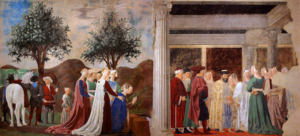
Gina Buffone is a sustainable building consultant for affordable housing and an Aesthetic Realism associate. She writes about this talk by Dorothy Koppelman (1920-2017), artist, Aesthetic Realism consultant and founder of the Terrain Gallery:
I love the talk by Dorothy Koppelman about two frescoes of Piero della Francesca: The Queen of Sheba Adoring the Holy Wood and The Resurrection, located in Arezzo and Sansepolcro, respectively, on the outskirts of Florence.
I studied art and lived for a time in Florence, spending hours in the museums and churches there. I was in awe of the Renaissance art and beauty that surrounded me. But I saw art as in a better world than the everyday world I lived in. And in my art history classes in college, I never learned why I felt so swept when I stood in front of works of art I loved, or what made them beautiful. I’m grateful to say I did learn the explanation when I began studying Aesthetic Realism.
The talk you are about to read is one of the high points of art criticism by one of the most important people in art history—American painter, art educator, and critic Dorothy Koppelman. Piero della Francesca’s beloved works have waited over five centuries to be understood as they are here. Mrs. Koppelman originally presented this talk in 2007 at the Piero della Francesca Foundation in Sansepolcro, Italy. It begins:
As I speak today about two of the magnificent works of Piero della Francesca, the principle at the basis of all I say is the following statement by Eli Siegel: “All beauty is a making one of opposites, and the making one of opposites is what we are going after in ourselves.” I am proud to say that I’ve seen this principle as true about every instance of art, true about the artist’s intention, and true about the effect of a work of art on ourselves. It enables us to more deeply understand the meaning of Piero’s art, including for our lives today.
Let us look now at the panel depicting the Queen of Sheba Adoring the Holy Wood. I shall discuss the left side of this large panel in which we see the journey of the Queen as she travels to speak to King Solomon.
